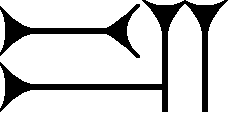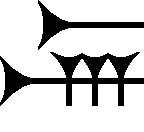|
Iš (cuneiform)
The cuneiform sign iš is a common use sign in the Amarna letters and the ''Epic of Gilgamesh.'' It is used syllabically for ''iš''; also for ''mel'', ''mil'', and a Sumerogramic usage for ''IŠ'' (Epic of Gilgamesh). Alphabetically as "iš", its most common usage, it can be used for "i" or "š". In Akkadian language, Akkadian, the four vowels ''a, e, i, o'', are all interchangeable, and the three different "s", can also be interchanged: ''s, ṣ, š''. ''Epic of Gilgamesh'' use For the ''Epic of Gilgamesh'', the following usage is found in Tablets I-XII: ''iš''-(134 times); ''mel''-(1); ''mil''-(8); IŠ-(18 times). Some common uses of "iš" in the Amarna letters One of the most common uses of "iš" in the Amarna letters, is the use of the Akkadian language word ''"ištu"'', which means "from", ("since"), in English language, English. In the ''vassal city-state'' letters, in dialogue with the Pharaoh-in-Egypt, there is often mention of having listened to the correspondence ... [...More Info...] [...Related Items...] OR: [Wikipedia] [Google] [Baidu] |
Simo Parpola
Simo Kaarlo Antero Parpola (born 4 July 1943) is a Finnish Assyriologist specializing in the Neo-Assyrian Empire and Professor emeritus of Assyriology at the University of Helsinki (retired fall 2009). Career Simo Parpola studied Assyriology, Classics and Semitic Philology at the University of Helsinki, the Pontifical Biblical Institute and the British Museum in 1961–1968. He completed his PhD in Helsinki and began his academic career as ''Wissenschaftlicher Assistent'' of Karlheinz Deller at the Seminar für Sprachen und Kulturen des Vorderen Orients of the University of Heidelberg in 1969. Between 1973 and 1976 he was Docent of Assyriology and Research Fellow at the University of Helsinki, and from 1977 to 1979 associate professor of Assyriology with tenure at the Oriental Institute of the University of Chicago. He was appointed extraordinary professor of Assyriology at the University of Helsinki in 1978 and has directed the University's Neo-Assyrian Text Corpus Project sin ... [...More Info...] [...Related Items...] OR: [Wikipedia] [Google] [Baidu] |
Claude Schaeffer
Claude may refer to: People and fictional characters * Claude (given name), a list of people and fictional characters * Claude (surname), a list of people * Claude Callegari (1962–2021), English Arsenal supporter * Claude Debussy (1862–1918), French composer * Claude Kiambe (born 2003), Congolese-born Dutch singer * Claude Lévi-Strauss (1908–2009), French anthropologist and ethnologist * Claude Lorrain (c. 1600–1682), French landscape painter, draughtsman and etcher traditionally called just "Claude" in English * Claude Makélélé (born 1973), French football manager * Claude McKay (1890–1948), Jamaican-American writer and poet * Claude Monet (1840–1926), French painter * Claude Rains (1889–1967), British-American actor * Claude Shannon (1916–2001), American mathematician, electrical engineer and computer scientist * Madame Claude (1923–2015), French brothel keeper Fernande Grudet Places * Claude, Texas, a city * Claude, West Virginia, an unincorporated co ... [...More Info...] [...Related Items...] OR: [Wikipedia] [Google] [Baidu] |
Old Babylonian
Old Babylonian may refer to: *the period of the First Babylonian dynasty (20th to 16th centuries BC) *the historical stage of the Akkadian language Akkadian ( ; )John Huehnergard & Christopher Woods, "Akkadian and Eblaite", ''The Cambridge Encyclopedia of the World's Ancient Languages''. Ed. Roger D. Woodard (2004, Cambridge) Pages 218–280 was an East Semitic language that is attested ... of that time See also * Old Assyrian (other) {{disambig ... [...More Info...] [...Related Items...] OR: [Wikipedia] [Google] [Baidu] |
Giorgio Buccellatti
Giorgio may refer to: * Castel Giorgio, ''comune'' in Umbria, Italy * Giorgio (name), an Italian given name and surname * Giorgio Moroder, or Giorgio, Italian record producer ** ''Giorgio'' (album), an album by Giorgio Moroder * "Giorgio" (song), a song by Lys Assia * Giorgio Bruno, a character from the video game ''Time Crisis 4'' * Giorgio Zott, the main antagonist from the video game ''Time Crisis 3'' * Giorgio Beverly Hills, a prestige fragrance brand See also * Georgios * Georgio (other) Georgio is a variant of George. It may refer to: Mononyms * Georgio (singer) (born 1966), full name Georgio Alentini, born George Allen. American singer, songwriter, and musician * Georgio (rapper) (born 1993), birth name Georges Édouard Nicolo, ... * San Giorgio (other) {{disambig ... [...More Info...] [...Related Items...] OR: [Wikipedia] [Google] [Baidu] |
Megiddo
Megiddo may refer to: Places and sites in Israel * Tel Megiddo, site of an ancient city in Israel's Jezreel valley * Megiddo Airport, a domestic airport in Israel * Megiddo church (Israel) * Megiddo, Israel, a kibbutz in Israel * Megiddo Junction, a motorway junction in northern Israel United States churches * Megiddo Mission, Rochester, New York * Megiddo Church, Rochester, New York People * Nimrod Megiddo, mathematician and computer scientist Fiction * '' Megiddo: The Omega Code 2'', a 2001 American film * "Megiddo", the 65th chapter and 34th episode of ''That Time I Got Reincarnated as a Slime'' * Prince Megiddo, a character in the Japanese television series ''Kagaku Sentai Dynaman'' * Aradia and Damara Megido, characters from the webcomic ''Homestuck'' (2009–2016) Music * ''Megiddo'' (EP), a 1997 EP by Satyricon * ''Megiddo'' (Lauren Hoffman album), 1997 * ''Dawn of Megiddo'', a song from the 1985 album '' To Mega Therion'' by the Swiss metal band Celtic Frost O ... [...More Info...] [...Related Items...] OR: [Wikipedia] [Google] [Baidu] |
Biridiya
Biridiya was the ruler of Megiddo, northern part of the southern Levant, in the 14th century BC. At the time Megiddo was a city-state submitting to the Egyptian Empire. He is part of the intrigues surrounding the rebel Labaya of Shechem. History Biridiya was the ruler of Magidda (Megiddo). At the time, Labaya of Shechem tried to expand his territory and power. Labaya attacked Megiddo (EA 244) forcing the people to flee inside the city walls and making it impossible to harvest fields. Both Biridiya and Yashdata (EA 248/EA 245) attacked Labaya, apparently with the support of Suruata of Akko. At one point Suruata took Labaya away from Megiddo to send him by boat to the Pharaoh, but he received a ransom and released Labaya (EA 245). Amarna Archive In Egypt, the Amarna Archive (c. 1350 BC) contained letters authored by Biridya. The archive covers diplomatic correspondence from the time of Amenhotep III, Akhenaten Akhenaten (pronounced ), also spelled Akhenaton or Echnaton ( '' ... [...More Info...] [...Related Items...] OR: [Wikipedia] [Google] [Baidu] |
Amarna Letter EA 271
Amarna letter EA 271, titled: ''"The Power of the 'Apiru,"'' is a moderately short, tallish, rectangular clay tablet letter, approximately 3 in wide x 4 in tall, from Milkilu the mayor/ruler of Gazru (Gezer), of the mid 14th century BC Amarna letters. The Canaanite city-states were visited by the scribes, with short 'status reports' sent to the Pharaoh (King) reporting on city or regional accounts, for example the troubles with the habiru, or other external affairs. Many of the Canaanite letters are short, with some nearly identical phraseology of words, as well as the layout of the individual clay tablet letters. Milkilu authored EA 268 through EA 271. Amarna letter EA 270-(29 lines) is nearly identical in shape to EA 271-(27 lines), with the beginning lines of the obverse, nearly identical in wording, and spacing. The Amarna letters, about 300, numbered up to EA 382, are a mid 14th century BC, about 1350 BC and 20–25 years later, correspondence. The initial corpus of let ... [...More Info...] [...Related Items...] OR: [Wikipedia] [Google] [Baidu] |
Pharaoh
Pharaoh (, ; Egyptian language, Egyptian: ''wikt:pr ꜥꜣ, pr ꜥꜣ''; Meroitic language, Meroitic: 𐦲𐦤𐦧, ; Biblical Hebrew: ''Parʿō'') was the title of the monarch of ancient Egypt from the First Dynasty of Egypt, First Dynasty () until the Roman Egypt, annexation of Egypt by the Roman Republic in 30 BCE. However, the equivalent Egyptian language, Egyptian word for "king" was the term used most frequently by the ancient Egyptians for their monarchs, regardless of gender, through the middle of the Eighteenth Dynasty during the New Kingdom of Egypt, New Kingdom. The earliest confirmed instances of "pharaoh" used contemporaneously for a ruler were a letter to Akhenaten (reigned –1336 BCE) or an inscription possibly referring to Thutmose III (–1425 BCE). In the early dynasties, ancient Egyptian kings had as many as ancient Egyptian royal titulary, three titles: the Horus name, Horus, the prenomen (Ancient Egypt), Sedge and Bee (wikt:nswt-bjtj, ''nswt-bjtj''), and ... [...More Info...] [...Related Items...] OR: [Wikipedia] [Google] [Baidu] |
Assyria
Assyria (Neo-Assyrian cuneiform: , ''māt Aššur'') was a major ancient Mesopotamian civilization that existed as a city-state from the 21st century BC to the 14th century BC and eventually expanded into an empire from the 14th century BC to the 7th century BC. Spanning from the early Bronze Age to the late Iron Age, modern historians typically divide ancient Assyrian history into the Early Assyrian period, Early Assyrian ( 2600–2025 BC), Old Assyrian period, Old Assyrian ( 2025–1364 BC), Middle Assyrian Empire, Middle Assyrian ( 1363–912 BC), Neo-Assyrian Empire, Neo-Assyrian (911–609 BC), and Post-imperial Assyria, post-imperial (609 BC– AD 240) periods, based on political events and gradual changes in language. Assur, the first Assyrian capital, was founded 2600 BC, but there is no evidence that the city was independent until the collapse of the Third Dynasty of Ur, in the 21st century BC, when a line of independent kings starting with Puzur-Ashur I began rulin ... [...More Info...] [...Related Items...] OR: [Wikipedia] [Google] [Baidu] |
Ru (cuneiform)
The cuneiform ru sign is found in both the 14th century BC Amarna letters and the ''Epic of Gilgamesh''. As ''ru'' it is used for syllabic ''ru'', and alphabetic 'r', or 'u'. In the I-XII Tablets of the ''Epic of Gilgamesh'', it has specific uses showing alternate renderings besides ''ru''; as sign no. 068, ''ru'', 250 times, ''šub'', 6, ''šup'', 3, and as Sumerogram ''ŠUB'', 1 time. In the Amarna letters, the sign is mostly used for ''ru'', ''r'', and ''u'' in the spelling of various words. Notably, for "bird", Akkadian language "iṣṣūru", in Amarna letter EA 28, (Tushratta to Pharaoh), titled ''"Messengers Detained and a Protest"''; the messengers are referenced as "uncaged" birds, and "aren't they free to come and go as birds do?". The scribal rendering of the ru sign is dramatically different in some of the Amarna letters. In Amarna letter EA 15, Assur-uballit I of Assyria to Pharaoh, and Amarna letter 28, (using bird, "iṣṣūru") it appears as the standard, elec ... [...More Info...] [...Related Items...] OR: [Wikipedia] [Google] [Baidu] |



